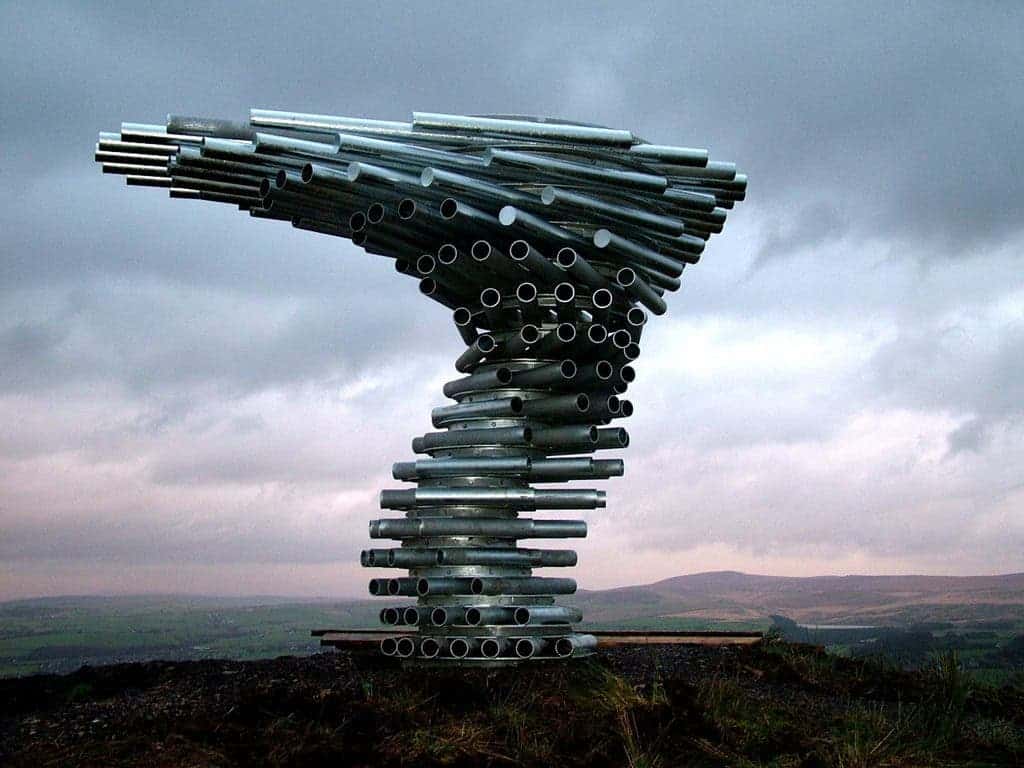A wind or Aeolian harp is exactly what the name implies: the only musical instrument played by the wind. An Aeolian harp is a small wooden box with a sounding board and strings attached to two bridges. People leave them outside an open window or place them inside their gardens to enjoy the distinct, ghostly tunes plucked by the wind. But some artists really took it to the next level.

A prime example is the aptly named Singing Ringing Tree, a 3-meter-tall musical sculpture made of galvanized steel pipes. Erected above the English town of Burnley, the pipes which swirl to form the shape of a tree are blown by the wind to produce a melodious hum. The sound produced by these twisted metal trees covers several octaves and is said to be simultaneously discordant and melancholy, and intensely beautiful.
Some of the pipes are primarily structural and visual elements, while others have been cut across their width enabling the sound. The harmonic and singing qualities of the tree were produced by tuning the pipes according to their length by adding holes to the underside of each.
The tree was designed by architects Mike Tonkin and Anna Liu, and was completed in 2006. In 2015, it was chosen as one of 21 landmarks that define Britain in the 21st Century, as voted by the public.

Lodged in the eastern edge of the Golden Gate National Recreation Area in San Francisco, lies one of the cities most obscure tourist attraction — the Wave Organ. The view alone is worth the journey, but those who venture this far are also treated with a work of environmental art created by Peter Richards and George Gonzales in 1986. “Someone made a recording of the sounds made by water going in and out of a concrete dock in Sydney, Australia. I’d been wanting to add an audible component to my art, and that tape gave me the idea for the Wave Organ,” Richards said in an interview.
Hundreds of volunteers excavated the site and installed PVC tubes to create the organ. These stick up like periscopes creating a sound akin to listening to the world’s largest sea shell — a distant hum and quiet thunder. Visitors are encouraged to position themselves on the many stone slabs with an ear propped against any of the dozens of listening tubes.

Not too far from the Wave Organ in Frisco, at the Exploratorium, lies the 27-foot-tall Aeolian Harp. It was designed and built by local artist Doug Hollis in 1976. “The artist specifically sited this piece to take advantage of the natural wind tunnel here between Piers 15 and 17. The wind picks up every day at around two or three o’clock and that’s when it really sings,” says curator Shawn Lani.

One of the most amazing wind harps can be found in Forks, Canada. This is the meeting place of the Winnipeg community, and the Forks Aeolian Harp — one of the largest in the world — provides an unique and compelling attraction. Crowds gather especially during the autumn equinox and the summer and winter solstices.
Aeolian Harps Physics
Named after the Greek god of the wind Aeolus, aeolian harps were invented by a German Jesuit at Rome, Athanasius Kircher, in the seventheeth century. The aeolian harp became a subject of European-wide scientific study and middle-class marketing during the Enlightenment and Romantic periods, but have since fallen out of fashion.
A common misconception about the wind harp is that its strings are tuned to different pitches. In fact, they are all tuned alike, but because they have different diameters, they vibrate in response to a common wind velocity at different frequencies.
To explain how it works, it’s worth briefly explaining a bit of music theory. The Greek mathematician Pythagoras found if you shorten a string to exactly half its size it will produce a tone an octave above its original note. Halve its length once more and you’ll get another octave higher. Other divisions of a string will result in other interval relationships, like fifths and thirds. These related notes above the fundamental note are harmonic overtones.
When a string is plucked, we hear mainly the fundamental note, but in addition, the harmonic overtones are also present. When the wind plays a string, it does not play the fundamental tone, but only the series of overtones. This makes the sound high-pitched and eerie. Bigger wind harps, like the ones featured in this article, will sound a bit lower and more mysterious since the strings are really long.
The wind plays the harp by creating little spirals of air called vortices that move to either side making oscillations. The strings of an aeolian harp are tuned to the same note, which means these will vibrate only when the wind’s frequency of the oscillation matches the frequency of the string tuning. In other words, an aeolian harp will only make sound for a particular wind speed.
To make the physics even more interesting, the strings are said to be driven by the von Kármán vortex street effect which describes the creation of periodic vortices downstream . Lord Rayleigh was the first to explain how the aeolian harp works in a paper published in the Philosophy Magazine, in 1915.







